Tags
April VeVea, Goodnight Marilyn, Immortal Marilyn, Marilyn Monroe, Marilyn Monroe: A Day in the Life
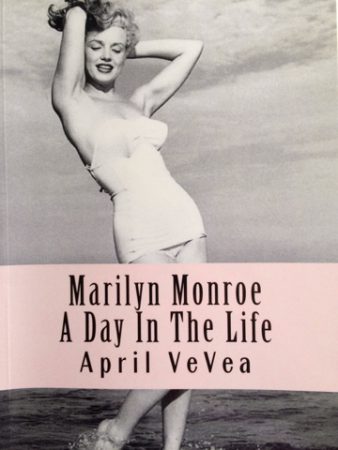
April VeVea is a 26 year-old ‘Marilynista.’ “My knowledge of her started in 1993, when I was three, and saw a life size cut-out in an antique store,” she recalls. “Marilyn had her dress blowing over her head in the iconic Seven Year Itch dress. As her smile radiated through me all I could think about were two things: her beauty and that she would look better with longer hair.” April also maintains a highly regarded blog, examining popular myths about Marilyn’s life and death. Inspired by authors like Donald Spoto and Michelle Morgan, April has uncovered primary sources, including newspaper archives and original documents from auction catalogues.
The creation of an accurate timeline for Marilyn’s life is not a new project. It is the culmination of many years’ research by fellow fans, most notably on the Everlasting Star forum and the Cursum Perficio website. While Marilyn’s sensual image continues to grab headlines, it is this small band of ardent admirers who help to keep her legacy alive. In recent years, fans like Stacy Eubank and Gary Vitacco-Robles have written comprehensive biographies, while scholars like Lois Banner and Carl Rollyson (who collated existing chronologies with in his 2014 book, Marilyn Monroe: Day by Day) have actively engaged with this community.
April’s first book, Marilyn Monroe: A Day in the Life, brings further detail to light. On the cover is an Andre de Dienes photo of Marilyn at Tobey Beach, New York in 1949, on the cusp of fame and rising like a twentieth-century Venus from the sand. Inside is a compact, but attractive selection of photos (not seen here), mostly taken at the peak of Marilyn’s career, and including a few with husbands Joe DiMaggio and Arthur Miller. Each chapter covers a year of her life, from her birth in Los Angeles in 1926 to her untimely death in 1962.
It is rather humbling to trace a person’s existence through a paper trail. We gain a clear picture of Norma Jeane’s orphan status (although it is more proper to say she was a waif) from the sundry expenses claims submitted by Grace Goddard, her legal guardian after 1936, to the state of Los Angeles for the child’s care. Of course, raising children is expensive – but never has the price been so neatly exposed.
On the other hand, her path to fame shows a formidable will. In the two-year period starting with her ‘discovery’ by an army photographer during World War II, to her first movie contract, Marilyn transformed her destiny. Skilled at matching the Monroe lore with proven facts, April convincingly argues that the starlet’s memory of being unsure how to spell her stage name when she was first asked for an autograph probably dates back to her riding a float at the Tournament of Roses Parade on New Year’s Day, 1947. April also solves the long-standing mystery of the photographs of Marilyn dressed in a red silk taffeta ballgown, and talking to fans in 1952. It was initially suggested that she was attending a movie premiere, but April reveals that Monroe was actually signing copies of her first Life magazine cover at a drugstore.
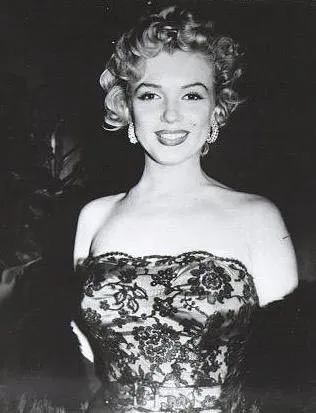
Marilyn greets fans in 1952
Many dubious stories have been propagated over the years, including an alleged secret marriage to journalist Robert Slatzer in Mexico on April 11, 1952. While Donald Spoto recovered a cheque signed by Marilyn in Los Angeles on that day, April notes that Monroe had attended a party in Hollywood the previous evening.
Throughout her journey to stardom, Marilyn was unwilling to commit to any agent for very long (with the exception of Johnny Hyde, who became her lover.) This reveals an independent streak unusual in an aspiring actress, especially one regarded by studio executives as little more than a pin-up. After her breakthrough year of 1953, when she starred in a string of hit movies, Marilyn refused to rest on her laurels and insisted that her current representative, Charles Feldman, negotiate with Twentieth Century-Fox to win her more creative control. When his efforts proved insufficient, she abandoned Hollywood entirely – only to return triumphant in 1956.
Production dates for her movies – sometimes scene-by-scene – and arrangements for her photo shoots create a broader sense of her artistic development, while personal notes and gifts shed light on her relationships. Frequently these two spheres collide, as during filming of Bus Stop when she was juggling a star-crossed romance with Arthur Miller (as evinced by his passionate love letters), an intense collaboration with photographer Milton Greene, as well as testing the waters as a Method-trained actress and pulling off a professional comeback.
Singer Ella Fitzgerald told of an incident when Marilyn had secured her a residency at the Mocambo Club by promising to attend every show. Many have assumed that the venue discriminated against Ella for being black, but this was not the case. As April points out, the iconic 1954 photographs of the two women were actually taken at the Tiffany Club, and while her kindness towards Ella is not in doubt, Marilyn only went there twice.
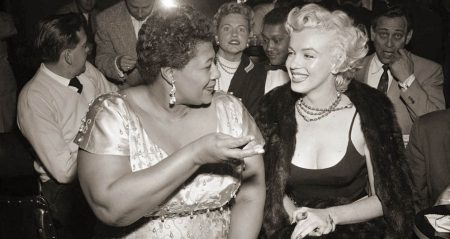
With Ella Fitzgerald, 1954
For all her talent and ambition, Marilyn was fragile – emotionally, and physically. Her later movies were beset by conflict with directors, and her own deep insecurity. Prone to respiratory illnesses, she was perpetually sick and exhausted while working. Her insomnia led to a dangerous reliance on sleeping pills. All of this led to palpable tension among her co-workers, and a growing reputation for being ‘difficult’ – that age-old slur against successful women.
There were also setbacks, particularly the dissolution of her business partnership with Greene and the subsequent decline of her production company. Only recently have we learned of her plans to re-establish this venture with Marlon Brando and Lee Strasberg. Along with her shelved television debut in Rain, this is one of many occasions which leads us to ponder what might have been.
After marrying Miller, Marilyn led a more private life and yearned to start a family. She endured miscarriages and several fruitless operations to relieve the pain of endometriosis. The ultimate failure of this relationship was devastating, although it paved the way for a reconciliation of sorts with ex-husband Joe DiMaggio, who visited her often. Her devoted, yet much-maligned publicist, Pat Newcomb, fired off many chatty letters to Marilyn, and sought opportunities on her behalf – becoming another of Marilyn’s closest allies in her final years.
More ominously, the break with Miller necessitated a more permanent return to Los Angeles to fulfil her old contract with Twentieth Century-Fox. The sequence of events surrounding her humiliating dismissal from Something’s Got to Give, and her mounting prescriptions and daily appointments with a Svengali-like psychoanalyst, Dr Ralph Greenson, in the last month of her life speak volumes about her lonely struggle.
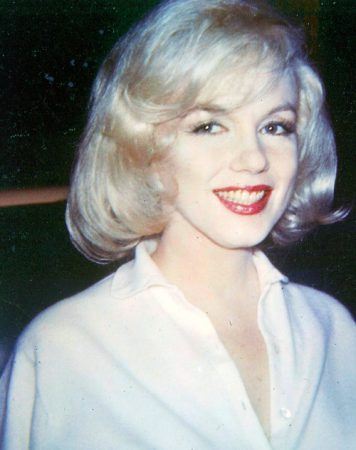
Leaving hospital in 1961
While the night of Monroe’s death has spawned endless allegations, April deals in facts, not speculation. As a panelist on the internet radio show, Goodnight Marilyn, she has been able to access the full report made by the Los Angeles District Attorney who re-opened the case in 1982. April also quotes a recent interview with forensic pathologist Dr Cyril Wecht for the show, in which Wecht estimated that Marilyn died at around 1:30 am on Sunday, August 5th, 1962.
“April VeVea is at the helm of a new of a new generation of Marilyn Monroe biographers dedicated to investigative journalism and painstaking research worthy of their subject,” Gary Vitacco-Robles writes in his foreword to Marilyn Monroe: A Day In the Life. April was kind enough to mention me on her acknowledgments page. She will also be donating a portion of the profits from this book to Animal Haven on behalf of Immortal Marilyn, which regularly raises funds for the charity.
From April’s timeline, the reader can observe patterns and construct their own narrative. Her style is succinct and unobtrusive, but some of the events she details would benefit from further explanation about Marilyn and the era in which she lived. Nonetheless, this is a superb reference guide and I look forward to reading April’s next book.
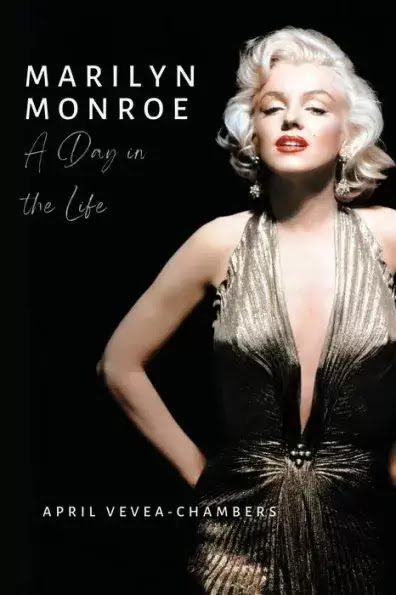 UPDATE: In 2022, April VeVea published a fully revised and expanded second edition of Marilyn Monroe: A Day in the Life, available via Barnes & Noble and Lulu
UPDATE: In 2022, April VeVea published a fully revised and expanded second edition of Marilyn Monroe: A Day in the Life, available via Barnes & Noble and Lulu

You must be logged in to post a comment.